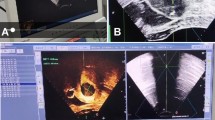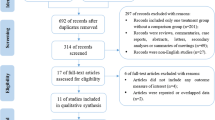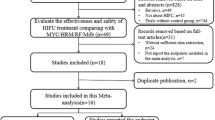Abstract
Objective
To evaluate the efficacy and safety of high-intensity focused ultrasound (HIFU) combined with the levonorgestrel intrauterine system (LNG-IUS) for adenomyosis.
Methods
We searched PubMed, Embase, Cochrane Library, Web of Science, CNKI, SinoMed, Wanfang, and VIP databases from their inception to Nov 20, 2021 for relevant articles that compared HIFU combined with LNG-IUS vs. HIFU alone in patients with adenomyosis. RevMan5.4 software was used for the data analysis. The primary outcome was changes in volume of the uterine. Secondary outcomes included visual analog scale (VAS) scores for dysmenorrhea, serum CA125 level, recurrence rate, changes in volume of the adenomyotic lesion, menstrual volume scores, and adverse reactions. Data synthesis was conducted using a random-effects model with significant heterogeneity (I2 > 50%), and using a fixed-effects model otherwise. This study is registered on the PROSPERO platform (CRD42021295214).
Results
The final analysis included 13 studies, with a total of 1861 patients. Results of analysis revealed that there was no significant difference in uterine volume reduction between the HIFU control group and the HIFU/LNG-IUS group at 3 months after procedure (MD:30.63). Compared with the HIFU control group, the HIFU/LNG-IUS group had more pronounced reduction in uterine volume at 6 (MD:29.04) and 12 months (MD:22.10) after procedure. The HIFU/LNG-IUS group has lower VAS scores for dysmenorrhea than the HIFU control group at 3 (MD:1.68), 6 (MD:1.69), and 12 months (MD:1.30) after procedure. Serum CA125 level in the HIFU/LNG-IUS group decreased more significantly than the HIFU control group at 6 (MD:18.34) and 12 months (MD:18.49) after procedure. The recurrence rate in the HIFU/LNG-IUS group was lower than that in the HIFU control group (RR:0.20).
Conclusions
Compared to HIFU control group, HIFU/LNG-IUS group for the management of adenomyosis had more advantages in alleviating symptoms and decreasing the volumes of the uterine and adenomyotic lesions. However, since the number of the included studies was too small and some of them were not RCT, this conclusion needs to be referenced with caution.








Similar content being viewed by others
Data availability
The original literature provided for the study is featured in the article. For more detailed information, the corresponding author may be contacted directly.
References
Vannuccini S, Petraglia F (2019) Recent advances in understanding and managing adenomyosis. F1000Res 8:F1000
Lacheta J (2019) Uterine adenomyosis: pathogenesis, diagnostics, symptomatology and treatment. Ceska Gynekol 84(3):240–246
Struble J, Reid S, Bedaiwy MA (2016) Adenomyosis: a clinical review of a challenging gynecologic condition. J Minim Invasive Gynecol 23(2):164–185
Zhai J, Vannuccini S, Petraglia F, Giudice LC (2020) Adenomyosis: mechanisms and pathogenesis. Semin Reprod Med 38(2–03):129–143. https://doi.org/10.1055/s-0040-1716687
Liu L, Wang T, Lei B (2021) Image-guided thermal ablation in the management of symptomatic adenomyosis: a systematic review and meta-analysis. Int J Hyperthermia 38(1):948–962
Mz Y, Ming X (2019) Application of high intensity focused ultrasound in the treatment of adenomyosis. Chin J Gynecol Obstet 35(05):522–527
Sheng J, Zhang WY, Zhang JP, Lu D (2009) The LNG-IUS study on adenomyosis: a 3-year follow-up study on the efficacy and side effects of the use of levonorgestrel intrauterine system for the treatment of dysmenorrhea associated with adenomyosis. Contraception 79(3):189–193. https://doi.org/10.1016/j.contraception.2008.11.004
Li L, Leng JH, Zhang JJ, Jia SZ, Li XY, Shi JH, Liu ZZ, You SS, Chang XY, Lang YH (2016) A prospective cohort study on the impact of placement timing of LNG-IUS for adenomyosis. Zhonghua Yi Xue Za Zhi 96(30):2415–2420
Xing W et al (2015) A clinical controlled study of HIFU combined with LNG-IUS in the treatment of adenomyosis. J Mod Med Health 31(12):1767–1769
Qing G et al (2016) A comparative study on the efficacy of high intensity focused ultrasound in the treatment of adenomyosis. Chin J Fam Plan Gynecotokol 8(09):49–54
Ye MZ et al (2016) Clinical study of high intensity focused ultrasound ablation combined with GnRH-a and LNG-IUS in the treatment of dysmenorrhea with adenomyosis. Chin J Obstet Gynecol 51(09):643–649
Zy W et al (2018) Clinical observation of high-intensity focused ultrasound combined with levonorgestrel intrauterine sustained-release system in the treatment of adenomyosis. Shandong Med J 58(03):65–67
lx Y, LY X (2019) Effects of high-intensity focused ultrasound combined with levonorgestrel intrauterine sustained-release system on serum CA 125, anti-endometrial antibodies, hemoglobin and ovarian function in patients with adenomyosis. Chin J Fam Plan Gynecotokol 11(4):33–36
Wen S (2019) High intensity focused ultrasound combined with levonorgestrel intrauterine contraceptive system in the treatment of adenomyosis. J China Prescr Drug 17(01):87–88
Han JJ, Yi JJ (2019) A comparative analysis of the curative effect of three regimens of high-intensity focused ultrasound in the treatment of adenomyosis. Health Horizon Med Sci 13:192
Feng Xu, Meng T et al (2020) Clinical study of high-intensity focused ultrasound combined with levonorgestrel intrauterine sustained-release system in the treatment of adenomyosis. J Chin Phys 22(08):1185–1188
Huang YiMei, QingLan Hu, Huang WenJing (2021) Application of high-intensity focused ultrasound combined with levonorgestrel intrauterine sustained-release system in the treatment of adenomyosis. Atrait Pmarmaceutical J 33(02):132–134
Jiang S, Guo HuiMing (2021) Analysis of the clinical efficacy and ovarian function of high intensity focused ultrasound combined with Mirena in patients with adenomyosis. China Med Eng 29(08):14–17
Jiang S et al (2021) Application of high intensity focused ultrasound ablation combined with levonorgestrel intrauterine sustained-release system in the treatment of patients with adenomyosis. Int Med Health Guid News 27(17):2651–2654
XiaoDi Bi (2021) Observation on the effect of comprehensive application of conservative treatment of adenomyosis. J XinJiang Med Univ
Li X, Zhu X, He S, Jiang Z, Li H, Tian X, Long W, Xue M, Deng X, Ye M (2021) High-intensity focused ultrasound in the management of adenomyosis: long-term results from a single center. Int J Hyperthermia 38(1):241–247
Sacks D, McClenny TE, Cardella JF, Lewis CA (2003) Society of interventional radiology clinical practice guidelines. J Vasc Interv Radiol 14(9 Pt 2):S199-202
American College of Obstetricians and Gynecologists (2008) ACOG practice bulletin. alternatives to hysterectomy in the management of leiomyomas. Obstet Gynecol 112:387–400
Ko JKY, Cheung VYT (2018) Comment on: delayed intestinal perforation and vertebral osteomyelitis after high-intensity focused ultrasound treatment for uterine leiomyoma. Obstet Gynecol Sci 61(2):177–178
Endometriosis professional committee of obstetrics and gynecology branch of chinese medical doctor association (2020) Chinese expert consensus on diagnosis and treatment of adenomyosis [J]. Chin J Obstet Gynecol 55(6):376–383
Siedek F et al (2019) Magnetic resonance-guided high-intensity focused ultrasound (MR-HIFU): overview of emerging applications (Part 2). Rofo 191(6):531–539
Pang LL, Mei J, Fan LX, Zhao TT, Li RN, Wen Y (2021) Efficacy of high-intensity focused ultrasound combined with gnrh-a for adenomyosis: a systematic review and meta-analysis. Front Public Health 16(9):688264
Abbas AM, Samy A, Atwa K, Ghoneim HM, Lotfy M, Saber Mohammed H, Abdellah AM, El Bahie AM, Aboelroose AA, El Gedawy AM, Mostafa M, Elsenity MA, Samy M, Safwat S, Abdelrahman RM, Salah El Din AS, Badran E, Abdelkader AM, Abdallah A (2020) The role of levonorgestrel intra-uterine system in the management of adenomyosis: a systematic review and meta-analysis of prospective studies. Acta Obstet Gynecol Scand 99(5):571–581. https://doi.org/10.1111/aogs.13798
Sangkomkamhang US, Lumbiganon P, Pattanittum P (2020) Progestogens or progestogen-releasing intrauterine systems for uterine fibroids (other than preoperative medical therapy). Cochrane Database Syst Rev. https://doi.org/10.1002/14651858.CD008994.pub3
Acknowledgements
The opinions expressed in this article are the subjective opinions of patients and do not represent the opinions of their affiliated organizations or the publishers, editors, and reviewers.
Funding
This study was supported by the two projects. They are analysis of real-world-based prognostic factors of HIFU treatment AM and the role of Chinese medicine intervention (2021MS060, Sichuan Provincial Administration of Traditional Chinese Medicine), and real-world-based study on the management of chronic disease in AM patients after HIFU with integrated Chinese and Western medicine (2020KFA3006, State Key Laboratory of Ultrasound in Medicine and Engineering). The funding organization does not have any role in the design or conduct of this study.
Author information
Authors and Affiliations
Contributions
T-TZ developed the search strategy and completed the manuscript writing. R-NL and L-XF completed the electronic search and selected appropriate literature. L-LY and T-TZ extracted the information of the selected studies. T-TZ was responsible for data analysis using RevMan 5.4 software. YW advised on the data analysis and was responsible for correspondence. All authors carefully checked and approved the final manuscript.
Corresponding author
Ethics declarations
Conflict of interest
The authors declared that the research was conducted in the absence of any commercial or financial relationships.
Additional information
Publisher's Note
Springer Nature remains neutral with regard to jurisdictional claims in published maps and institutional affiliations.
Rights and permissions
Springer Nature or its licensor holds exclusive rights to this article under a publishing agreement with the author(s) or other rightsholder(s); author self-archiving of the accepted manuscript version of this article is solely governed by the terms of such publishing agreement and applicable law.
About this article
Cite this article
Zhao, TT., Pang, LL., Yang, LL. et al. Efficacy of high-intensity focused ultrasound combined with LNG-IUS for adenomyosis: a systematic review and meta-analysis. Arch Gynecol Obstet 308, 351–362 (2023). https://doi.org/10.1007/s00404-022-06720-z
Received:
Accepted:
Published:
Issue Date:
DOI: https://doi.org/10.1007/s00404-022-06720-z




